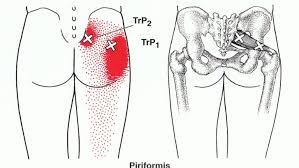|
Trigger points are commonly referred to as “knots” in a muscle. They are often an overlooked cause of pain even though they are very common in the musculoskeletal system. They are defined as “a hyperirritable spot in a taut band of a skeletal muscle that is painful on compression, stretch, overload or contraction of the tissue which usually responds with a referred pain that is perceived distant from the spot” (Simone et al 1999). Essentially, they are tender areas to touch, and often can be sending pain signals even when they are not touched. Although any muscle in the body can have trigger points, a muscle that is commonly involved is the piriformis. This is a deep hip rotator muscle that is shown in the picture above. Trigger points in this area can cause pain through the whole glut region, making it difficult to sit, walk, or pick up your leg, as in putting on a sock. Because they contribute to decreased muscle flexibility and strength it may be difficult to perform daily activities. Treatment for trigger points includes: heat, stretching, direct pressure, manual therapy, and dry needling. Dry needling is a skilled intervention that uses a thin needle to stimulate the myofascial trigger points and connective tissues in order to diminish the pain input and improve function. You can find more information on dry needling under that section of our website. Something you can do at home is to use a tennis ball over the tender area, as the direct pressure holding for about 1-2 minutes will help to alleviate the trigger point. Heat and gentle stretches will help also. Heat should be used for about 15 minutes at a time, and stretches should be held for 30 seconds-1 minute, repeated 2-3x. Below is a picture of a piriformis stretch.
0 Comments
Your comment will be posted after it is approved.
Leave a Reply. |
AuthorsA collaborative effort from the experienced staff at IT&W Archives
May 2023
Categories |
Blog updates |
|
2224 Virginia Beach Blvd Suite 106, Virginia Beach, VA 23454


 RSS Feed
RSS Feed

